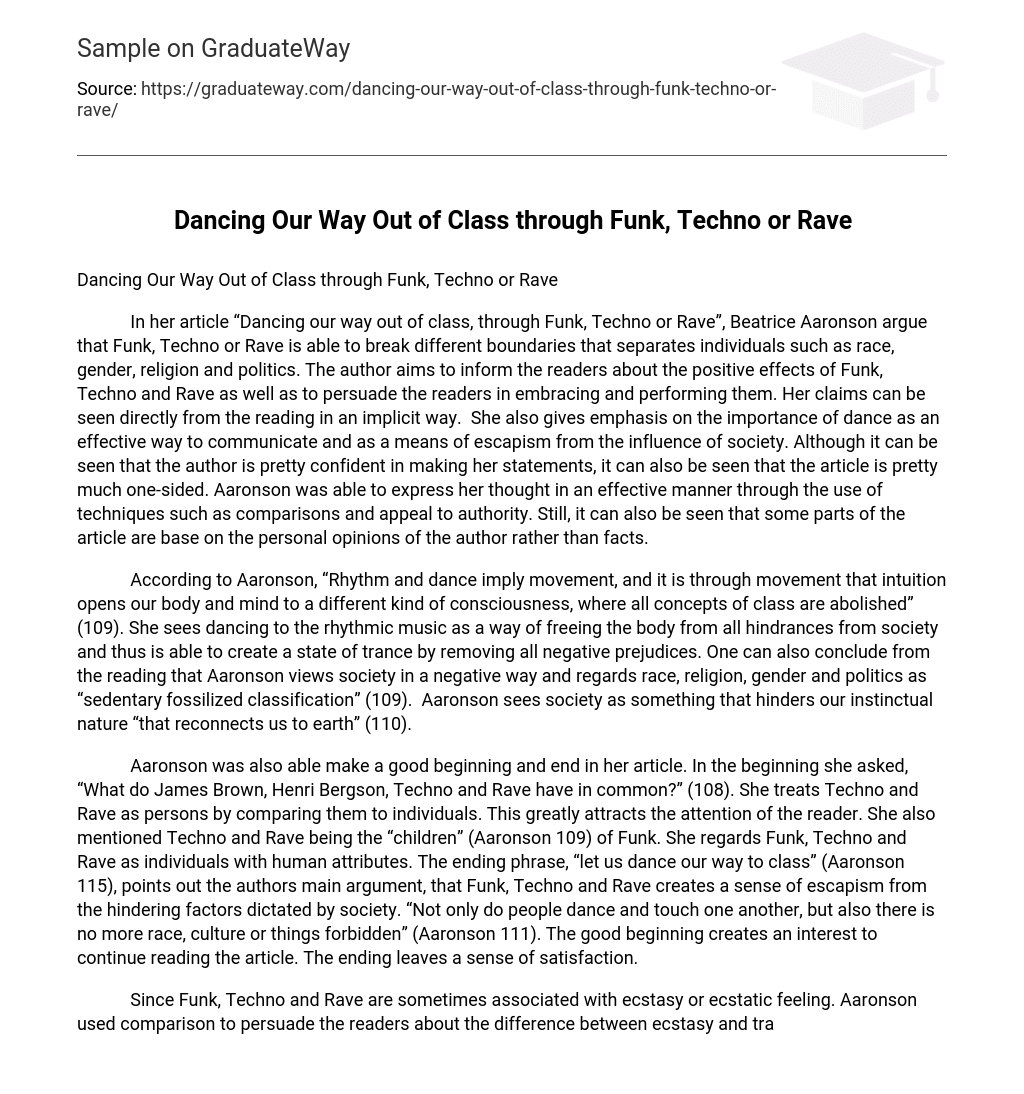In her article “Dancing our way out of class, through Funk, Techno or Rave”, Beatrice Aaronson argue that Funk, Techno or Rave is able to break different boundaries that separates individuals such as race, gender, religion and politics. The author aims to inform the readers about the positive effects of Funk, Techno and Rave as well as to persuade the readers in embracing and performing them. Her claims can be seen directly from the reading in an implicit way. She also gives emphasis on the importance of dance as an effective way to communicate and as a means of escapism from the influence of society. Although it can be seen that the author is pretty confident in making her statements, it can also be seen that the article is pretty much one-sided. Aaronson was able to express her thought in an effective manner through the use of techniques such as comparisons and appeal to authority. Still, it can also be seen that some parts of the article are base on the personal opinions of the author rather than facts.
According to Aaronson, “Rhythm and dance imply movement, and it is through movement that intuition opens our body and mind to a different kind of consciousness, where all concepts of class are abolished” (109). She sees dancing to the rhythmic music as a way of freeing the body from all hindrances from society and thus is able to create a state of trance by removing all negative prejudices. One can also conclude from the reading that Aaronson views society in a negative way and regards race, religion, gender and politics as “sedentary fossilized classification” (109). Aaronson sees society as something that hinders our instinctual nature “that reconnects us to earth” (110).
Aaronson was also able make a good beginning and end in her article. In the beginning she asked, “What do James Brown, Henri Bergson, Techno and Rave have in common?” (108). She treats Techno and Rave as persons by comparing them to individuals. This greatly attracts the attention of the reader. She also mentioned Techno and Rave being the “children” (Aaronson 109) of Funk. She regards Funk, Techno and Rave as individuals with human attributes. The ending phrase, “let us dance our way to class” (Aaronson 115), points out the authors main argument, that Funk, Techno and Rave creates a sense of escapism from the hindering factors dictated by society. “Not only do people dance and touch one another, but also there is no more race, culture or things forbidden” (Aaronson 111). The good beginning creates an interest to continue reading the article. The ending leaves a sense of satisfaction.
Since Funk, Techno and Rave are sometimes associated with ecstasy or ecstatic feeling. Aaronson used comparison to persuade the readers about the difference between ecstasy and trance. According to Aaronson, “trance is associated with “sensorial overstimulation, such as noise, agitation and visual assaults… trance dance is movement” and “needs a crowd” (110). On the other hand, “ecstasy is associated with sensorial privation such as silence, obscurity and fasting… ecstasy is immobility” and “needs solitude” (Aaronson 110).
One of the strongest techniques used in the paper is appeal to authority. By using known personalities and incorporating their ideas in the article, Aaronson was able to create a sense of objectivity and builds up the credibility of her claim. She used personalities such as James Brown, Henri Bergson, Merce Cunningham, Gilbert Rouget, Shiela Walker and Rodney Needham in order to support her claim and ideas. Although it can be seen that Aaronson herself knows a lot about the importance and effect of music and dance and can be regarded as a professional in the field, the use of other personalities greatly builds up her credibility and that of the article as a whole. In any objective article or research, it is always important to support your claims by incorporating ideas from different respected and renowned person in the field of your study and Aaronson was able to establish this aspect of objective writing.
Although the author herself can be considered knowledgeable in the said field and was able to build credibility in the paper through the used of different techniques, it can also be seen that the article is very much one-sided, pretty much in favor of Funk, Techno and Rave. All the supporting information and arguments created by the author adds up in favor of her claim. Although after reading the whole article we can see that Aaronson was encouraging the readers to embrace Funk, Techno and Rave, only providing the positive effects and characteristic of the dances makes the paper more informative and loosing the persuasive aspect of the article. The side that the author will take in the paper can also be easily seen in the first paragraph. By doing so, the readers are well aware of the author’s point of view even before reading the rest of the article.
The subjectivity of some arguments can also be seen. The words “I think” and “I believe” which were used by the author greatly decreases the objectivity of the paper and creates a sense that the arguments and information are opinion based rather than factual and concrete ideas.
Although there are some biases than can be seen in the article it can be said that the author was able to achieve her goal. Aaronson may have not been able to create a very argumentative article but she was able to inform the readers about the positive effects of Funk, Techno and Rave which can be considered the primary objective of the article. Since Funk, Techno and Rave are being condemned by many people as well as other society and culture, the article greatly helps in changing the image of Funk, Techno and Rave.
Work Cited
Aaronson, Beatrice. “Dancing Our Way Out of Class through Funk, Techno, or Rave”.





